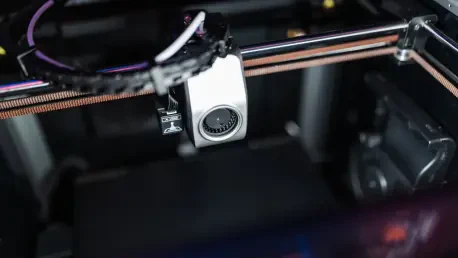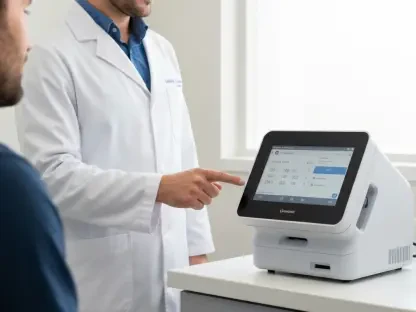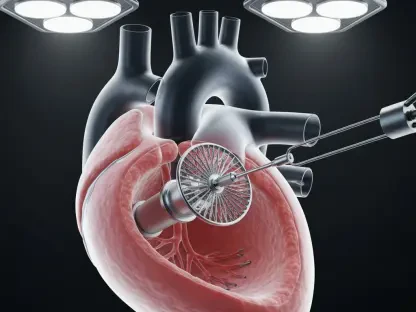The advancement of technology in healthcare is at the forefront of revolutionizing medical diagnostics, aiming to diagnose diseases at an early stage with higher accuracy and efficiency. Once a distant dream, the use of sensors for detecting biomarkers of various diseases is swiftly becoming a reality. A remarkable innovation has emerged in Hong Kong, where researchers are pushing the boundaries of biomedical technology by integrating 3D micro-printed microlaser sensors on lab-on-a-chip platforms. This technology promises to make significant strides in identifying diseases such as cancers, Alzheimer’s, and infections quickly, which could fundamentally transform the landscape of medical care.
3D Micro-Printed Microlaser Sensor Technology
The Genesis of the Limacon Microdisk
The pioneering sensors developed at The Hong Kong Polytechnic University leverage polymer whispering-gallery-mode (WGM) microlasers to expand the horizons of biosensing technology. These sensors function by capturing light within microcavities and detecting alterations in the laser frequency as target molecules bind to these cavities. A distinctive feature of this design is the Limacon-shaped disk microcavity, facilitating the identification of subtle concentrations of biomarkers like human immunoglobulin G (IgG). Unlike traditional methods that relied heavily on tapered optical fibers, which were often susceptible to environmental disturbances, the Limacon microdisk circumvents these hurdles, providing greater stability and integration within real-world lab-on-a-chip devices.
The microdisk’s unique shape enhances light emission efficiency while mitigating the dependency on external light couplers, streamlining integration into lab-on-a-chip applications. The meticulous design and implementation, achieved with in-house 3D micro-printing technology, allow for the precise and flexible fabrication of these sensors. This manufacturing approach supports the rapid prototyping of sensor arrays, proving to be a critical component in the race for ultra-sensitive diagnostic tools. The capability of the sensors to function at a low lasing threshold of 3.87 μJ/mm² and exhibit a narrow lasing linewidth marks a significant leap in biosensing performance, encouraging the exploration of new applications in early disease detection.
Sensitivity and Specificity
The exceptional sensitivity of these microlaser sensors facilitates detection at mere attograms per milliliter, showcasing remarkable precision in identifying biomarkers critical for early disease intervention. Their capability to precisely measure IgG concentrations could pave the way for breakthroughs in developing real-time and point-of-care diagnostic devices. By successfully overcoming barriers often faced by traditional biosensing methods, these sensors promise to deliver efficient and cost-effective solutions in medical diagnostics. Researchers aspire to integrate microlaser sensors into microfluidic chips to create optofluidic biochips capable of rapidly and quantitatively detecting multiple disease biomarkers simultaneously.
This ambitious objective addresses intrinsic challenges in biosensing technologies, including alignment difficulties and susceptibility to environmental perturbations. The directional light emission and enhanced integration efficiency spotlight their potential to reshape medical diagnostics. With enhanced sensitivity and specificity, these sensors hold the promise of redefining early intervention strategies, moving healthcare closer to personalized medicine that is both accessible and thoroughly comprehensive. The goal is to harness this innovation to deliver more precise and timely medical diagnoses, ensuring treatment and management decisions are substantiated by robust data.
Future Developments in Lab-On-A-Chip Technology
Integration and Efficiency
Moving forward, achieving seamless integration of microlaser sensors into lab-on-a-chip platforms remains paramount. The ambition is to craft biochips that blend optics with fluidics, optimizing the detection of multiple biomarkers with unmatched precision and speed. Future developments will likely focus on advancing the scalability of these sensors and enhancing their functionality to cater to a broader range of diseases and medical conditions. By addressing existing challenges and expanding the capabilities of integrated sensor systems, researchers aim to develop versatile biochips that transform healthcare diagnostics into more holistic, patient-centered approaches.
Achieving integration complements key technological milestones such as directional light emission, significantly elevating the sensors’ operational efficiency. These efforts are crucial in meeting the rising demand for personalized and proactive healthcare services. As health monitoring becomes incremental in enhancing overall well-being, developing sophisticated lab-on-a-chip devices reflects the pressing need to deliver precise diagnostic tools capable of detecting conditions promptly and accurately. As medical technology advances, there remains an ongoing exploration to leverage these sensors for broader applications ranging from routine check-ups to complex diagnostic scenarios.
Potential Impact
With the emergence of such groundbreaking technology, the paradigms of medical diagnostics are anticipated to shift markedly. The development of 3D micro-printed microlaser sensors heralds transformative changes in the approach to disease detection and management. By prioritizing early detection, the potential to minimize disease progression and improve patient prognosis is significantly amplified. These advances pave the way for substantial improvements in healthcare outcomes, as rapid and accurate diagnosis becomes indispensable in curbing disease incidence.
In future developments, the integration of 3D microlasers into comprehensive diagnostic systems is poised to revolutionize the medical industry. The research and innovation surrounding this technology promise to drive progress in realizing effective healthcare solutions, reducing healthcare costs, and increasing accessibility to high-quality medical care. As researchers continue to refine and expand these technologies, a better, more informed healthcare system becomes conceivable, characterized by precision, efficiency, and the ability to rapidly respond to emerging health challenges.
Shaping the Future of Medical Diagnosis
The continual progress of technology is reshaping the healthcare sector, especially in the realm of medical diagnostics. The objective is to identify diseases at their earliest stages with improved precision and speed. The concept of using sensors to detect biomarkers associated with a variety of illnesses was once a distant aspiration. Today, it is quickly becoming a reality, largely due to groundbreaking work emerging from Hong Kong. Here, researchers are at the cutting edge of biomedical technology, innovatively fusing 3D micro-printed microlaser sensors with lab-on-a-chip platforms. This pioneering technology holds the potential to make major strides in healthcare by enabling the rapid identification of diseases like cancer, Alzheimer’s, and various infections. Such advancements could dramatically change how medical care is approached and delivered, making it more efficient and potentially life-saving. This fusion of technology and medicine stands to revolutionize healthcare, making previously unattainable goals within reach.









